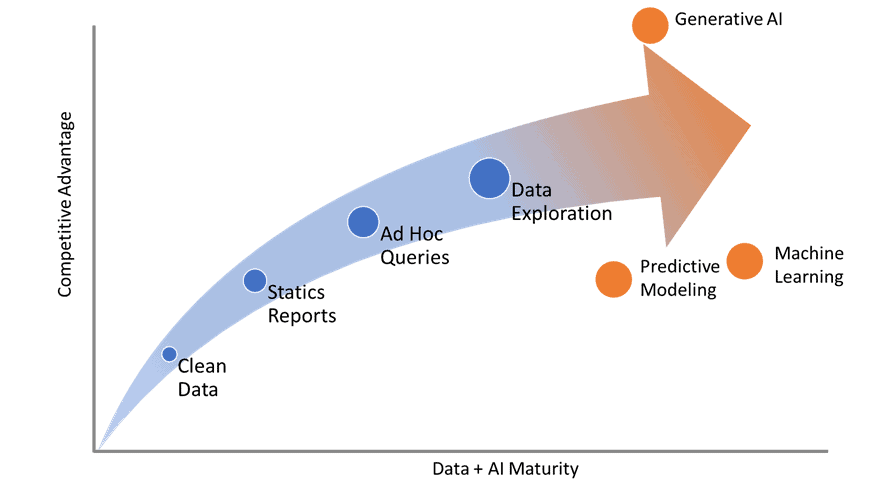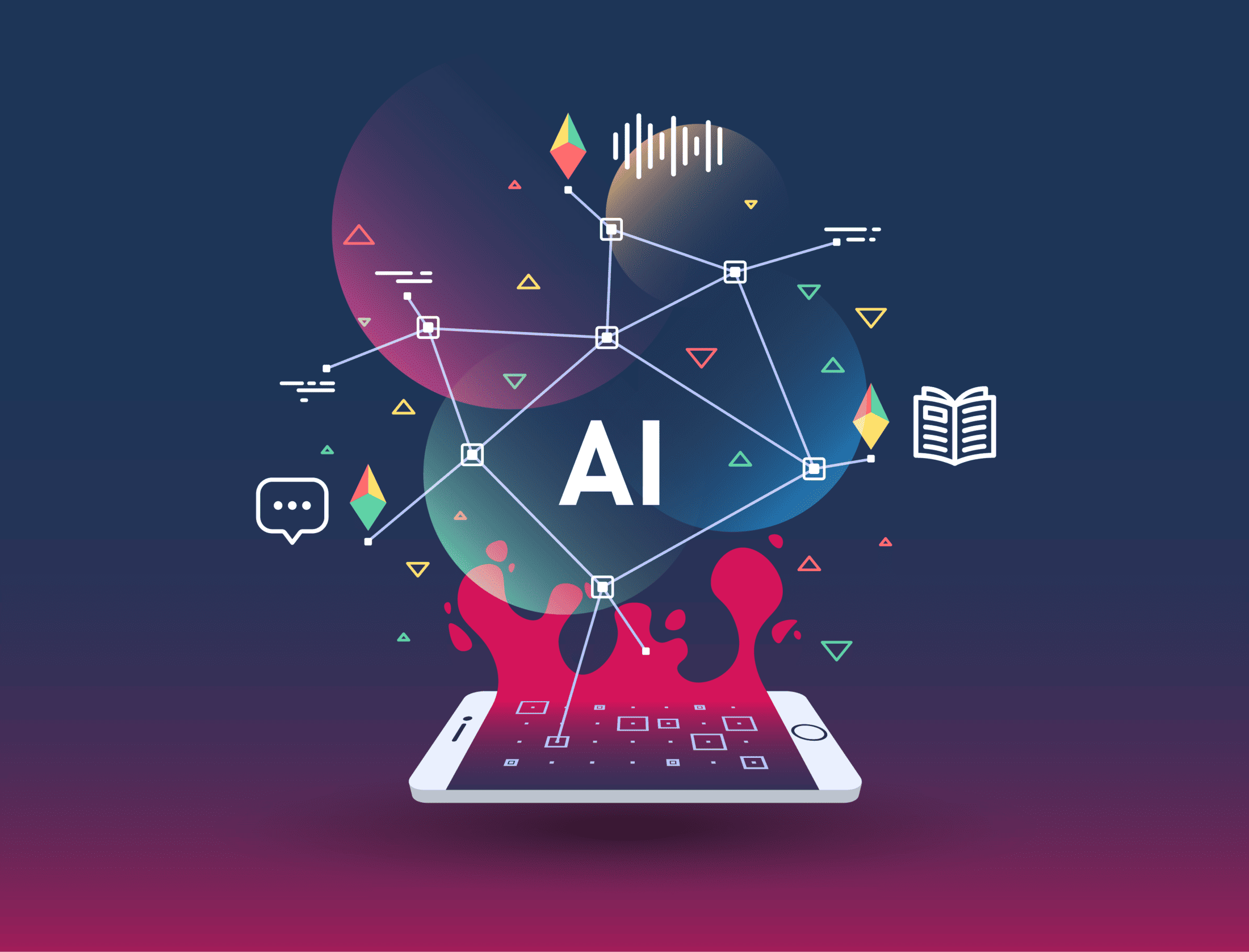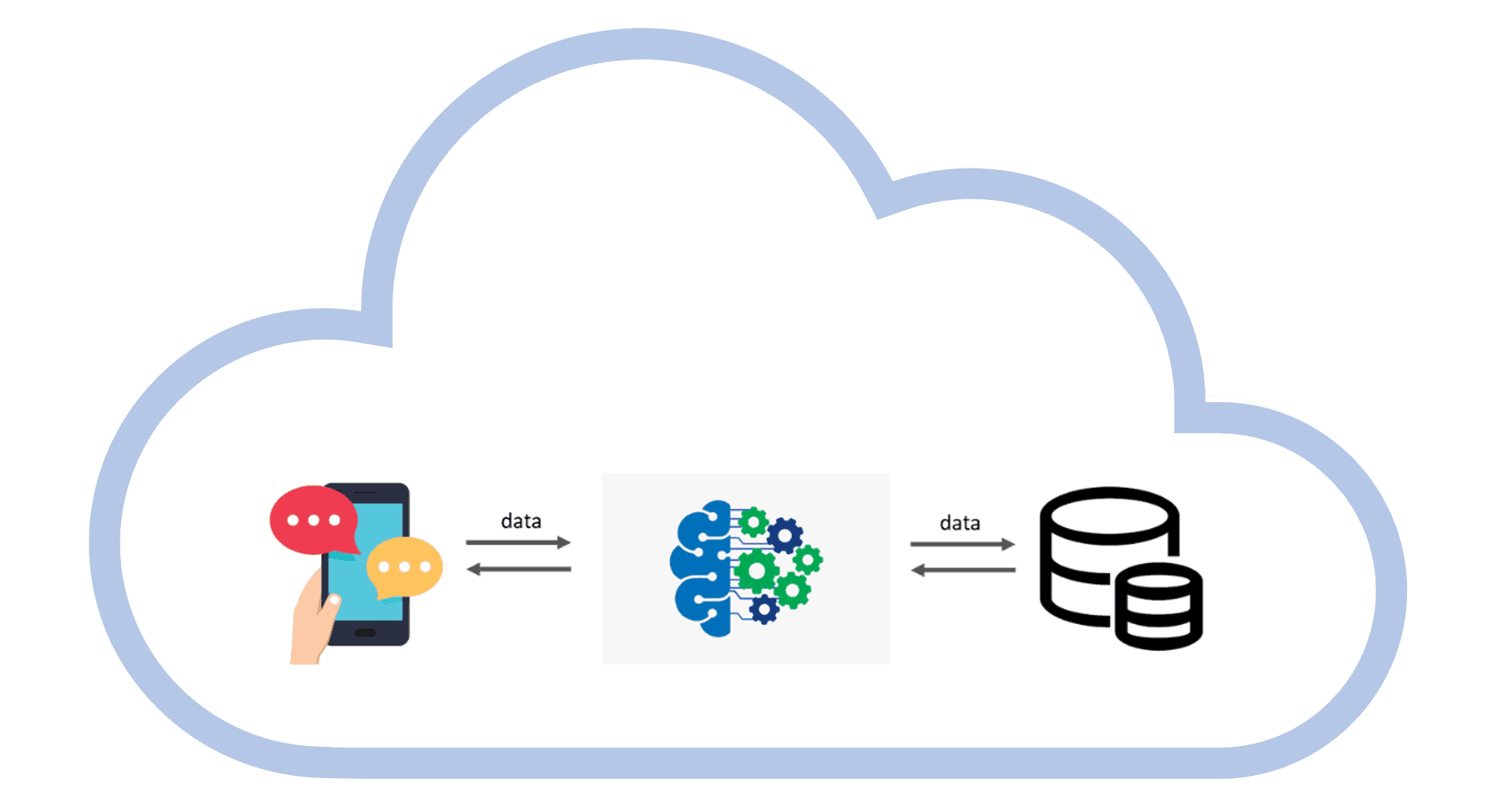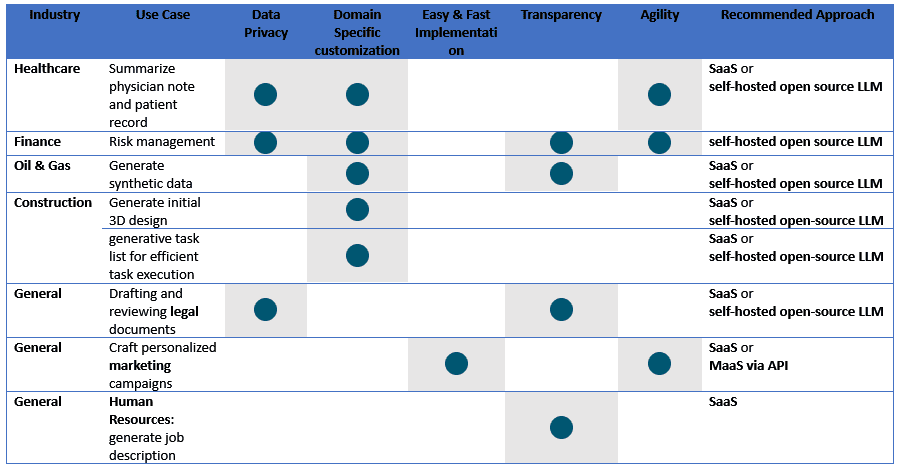A Guide to Evaluating and Choosing the Right Generative AI for Your Enterprise
We’ll discuss the alignment of generative AI capabilities with specific business needs, the various approaches to adoption (SaaS, MaaS via API, and self-hosted open-source models), and provide a recommended decision-making process for choosing the right approach based on industry use cases.
With its remarkable ability to produce creative content, generative AI is capturing the world’s attention and transforming industries in ways never seen before. Experts predict it will automate up to 50% of current work activities and deliver trillions of dollars in benefits to businesses worldwide.1, 2
In our first article of this generative AI series, we unveiled the boundless opportunities that lie ahead for industries embracing this cutting-edge technology. We revealed how generative AI can revolutionize your operations, drive revenue, and unlock newfound work efficiencies.
Why? What? How?
When considering the integration of generative AI into business operations, it is crucial to approach the decision with careful consideration. Smartbridge advises decision-makers to ask three fundamental questions: why, what, and how. These questions serve as valuable guides in determining the rationale, objectives, and implementation strategies for adopting this transformative technology.
Why: Evaluating AI/ML Solutions For Your Unique Challenge
Generative AI holds immense potential, but its true value is realized when its capabilities align with specific business needs. This innovative machine learning (ML) solution empowers businesses to quickly generate text, images, audio, or code, revolutionizing areas such as content creation, computer code writing, conversational chatbots, knowledge management, and creativity. Knowledge workers and creators stand to gain significant efficiency benefits from this technology, especially in fields where creativity drives success.

Figure 1: Generative AI can be run in parallel with predictive modeling and machine learning. A combination of generative AI and traditional machine learning will enable an enterprise’s full AI transformation. (Original idea adapted from Databricks3, with modifications based on Smartbridge’s understanding)
However, it’s crucial for companies to consider that while generative AI is powerful, it can be computationally intensive, which makes it’s not always the most suitable solution for every business challenge. Many traditional AI/ML approaches, including classification, regression, forecasting, computer vision, and traditional natural language processing (NLP), can already meet various business needs effectively. Developing and deploying smaller and simpler ML models offer advantages such as resource efficiency and faster inferencing time. Therefore, it is essential for businesses to ask themselves, “Can a smaller and simpler traditional ML solution effectively address the pain points we are experiencing?” before embarking on a generative AI journey.
By understanding the alignment between generative AI capabilities and specific business requirements, enterprises can make informed decisions that optimize outcomes and drive success. Unsure of the best AI solution for your business challenges? Our Smartbridge AI/ML experts can help evaluate which AI solution is the right fit for your unique challenges and goals.
What: Aligning Generative AI Capabilities with Business Needs
Generative AI operates by generating an output based on an input, but the categorization of models varies depending on the functionalities they offer. These categories include text-to-text, text-to-image, text-to-video, text-to-3D, text-to-task, image-to-image, and more. Different functionalities are likely to have different solution providers, leading to variations in setup processes, technology performance, cost, and security considerations.

Figure 2: Businesses should carefully consider the specific type of generative AI that aligns with their use case. Is it intended for tasks such as coding, content generation, conversational chatbots, or text/audio conversion, among others
Once the type of model is determined, users must define the scope of its capabilities. Is a broad range of tasks required? Is there a specific objective to be achieved? Take a large language model (LLM) for example. LLM is a type of neural network machine learning model used for a variety of natural language processing (NLP) tasks. If the audience intends to use a chatbot, which involves various tasks such as content generation, summarization, extraction, and content editing/rewriting, the scope is wide. Conversely, if the focus is on a specific need like summarization or translation, the scope is narrow.
In situations where the requirement is more specific, businesses have a wider range of choices, including specialized commercial applications, developed services, and open-source models. By aligning the solution selection with the scope of business needs, enterprises can reduce technology adoption costs and enhance model performance and user experience.
How: Picking the Right Approach to Generative AI Adoption
When an enterprise recognizes the need for generative AI to drive its growth, selecting the right approach and model becomes crucial for successful implementation. One example is utilizing a Large Language Model (LLM), which offers three high-level options: Software-as-a-Service (SaaS), Model-as-a-Service (MaaS) via API or self-managing an open-source LLMs .
Each one of the three options comes with advantages and disadvantages. The comparison between the three options is summarized in the table below:
| SaaS | MaaS LLMs | Open Source LLMs | |
|---|---|---|---|
| Control/ownership | Vendor-controlled and owned | Vendor-controlled and owned | Fully open |
| Security/privacy | Data leaves the company-managed environment | Data leaves the company-managed environment | Data stays within the company-managed environment |
| Customization | Vendor dependent | Vendor dependent | Fully customizable |
| Transparency | Underlying code, model weights, and training data can be an opaque box | Underlying code, model weights, and training data can be an opaque box | Source code, model weights, and training data are open & available |
| Access | Vendor built UI | via API, reliant on 3P SLA | Self-hosted or hosted by the platform |
| Development Effort | Low | Low-Medium | Medium-High |
| Compute Resource | Managed by vendor | Managed by vendor | On-premises or provided by the platform (suggested) |
| Post-deployment (monitor, maintain, & update) | The vendor takes care of the maintenance and updates | The vendor takes care of the maintenance and updates | Company is responsible |
| Examples | Copy.AI, Jasper, Aisera, Chatsonic, Bloomberg GPT | Open AI, Cohere | Databricks Dolly, Meta AI LLaMA, Hugging Face, Azure Machine Learning Model catalog |
Comparison between the three options: SaaS, MaaS via API and open-source models. This comparison is developed in reference to Databricks content.3
Approach 1: SaaS
The market is witnessing a rapid influx of generative AI startups that leverage foundational AI models (such as OpenAI and Stability AI) and provide services in a specific area. Over the past year and a half, approximately 50 startups specializing in text processing and 25 startups focusing on image processing in the domain of generative AI have emerged as of 2022.4
Sales and marketing professionals seeking personalized and domain-specific copywriting applications powered by generative AI can explore established products like Copy.AI, Jasper, and similar offerings. Likewise, Aisera, an AI services company, provides an AI-Driven Help Desk and Customer Service solution that utilizes Conversational AI for streamlining customer services and help desk automation. Financial professionals can also rely on Bloomberg GPT for natural language processing (NLP) tasks.
Approach 2: MaaS via API
MaaS via API involves connecting to a vendor’s API through a program or script, making the process simple and efficient. The models provided by the vendor are usually of high quality and up-to-date, ensuring optimal performance and faster response times. However, concerns may arise regarding data residency and privacy, as well as limitations on customization and potential risks if the service is discontinued.

Figure 3: Pipeline of MaaS providing LLM model service through API.
Approach 3: Self-Hosted Open-Source Models
Self-managing an open-source model grants greater flexibility and independence from third-party vendors. It allows for more choices, potentially reducing costs, and eliminates the reliance on external service providers. However, this option requires a more extensive setup, data science expertise, and infrastructure management. Performance-wise, open-source models may not be as powerful or cover a wide range of topics compared to vendor-provided large models.

Figure 4: self-hosting open-source model where all assets (model and data) are within the company’s cloud or on-premises platform.
Azure OpenAI Service offers the best of both worlds by providing advanced large language AI with OpenAI models like GPT-4, GPT-3, Codex, and DALL-E, within the secure and enterprise-focused environment of Azure. It combines the ease of using proprietary MaaS solutions with the added security benefits of Azure. This integration ensures data security for existing Azure users while maintaining access to the latest LLMs effortlessly.5
An Enterprise’s Guide to Picking the Right Approach
Smartbridge has established significant partnerships with industries such as Energy, Oil & Gas, Restaurant & Food Services, Construction, and Life Sciences. Drawing upon our extensive 20 years of experience working closely with clients, we would like to offer some recommendations for key use cases within these industries. The provided chart serves as an initial reference for those considering the adoption of generative AI technologies. However, it is important to note that the specifics of the adoption process will vary on a case-by-case basis.

Table: Smartbridge’s recommended decision-making process for picking the right LLM approach for your business use case.
To choose the right approach to generative AI, enterprises should consider factors such as model quality, serving cost, serving latency, and customizability. Instead of adhering strictly to one path or another, it is essential to carefully evaluate the use case and various factors that will ultimately determine the most suitable approach. For instance, in a legal firm where data and information are highly sensitive, it is advisable to ensure that the data never leaves the company’s environment. In such cases, opting for a self-hosted open-source model would be a preferable choice. As AI innovation continues to progress rapidly, more options will emerge, providing enterprises with even greater possibilities.
Smartbridge recommends using Azure Open AI or similar, with the ability to access the most updated model, customized to the industry domain and the company. This recommendation was based on the life cycle cost of the model, data privacy and security, efficiency, and long-term maintainability.
By now, you should have a better understanding of whether their business use cases require a generative AI solution, the type of solution to consider, and the optimal approach for adoption. However, it is equally crucial to establish a framework and ensure all necessary resources are in place for the successful implementation of a generative AI solution. In an upcoming article of this generative AI series, we will explore the potential risks associated with generative AI and present an enterprise checklist for assessing its readiness in terms of people, processes, technology, and data.
This article was written as a collaborative effort between our data scientist, Cecile Wang and Managing Director of Innovation & Analytics, Rajeev Aluru.
- AI automation could take over 50% of today’s work activity by 2045: McKinsey (cointelegraph.com)
- Economic potential of generative AI | McKinsey
- Build Your Own Large Language Model Like Dolly | Databricks
- ai revenue, growth rate & funding | Sacra
- What is Azure OpenAI Service? – Azure Cognitive Services | Microsoft Learn
Looking for more on AI/ML?
Explore more insights and expertise at smartbridge.com/ai
There’s more to explore at Smartbridge.com!
Sign up to be notified when we publish articles, news, videos and more!
Other ways to
follow us:


